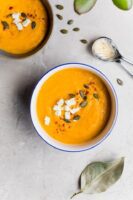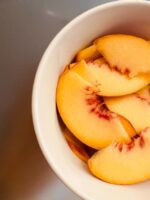8 Recommended Foods for a Dysphagia Diet
 Submitted by Beth Rush
Submitted by Beth Rush
Founder and Managing Editor
Body+Mind Magazine
After someone receives a dementia or Alzheimer’s diagnosis, many factors in their life start changing. They may need to adjust their routine and get more assistance with daily activities, especially if they begin experiencing dysphagia.
This article explains everything you should know about dysphagia and how you can update someone’s diet to provide the nutrition they need without endangering their health. It’s a manageable part of living with memory loss conditions if you know where to start.
What Is Dysphagia?
Dysphagia occurs when someone has difficulty swallowing due to a loss of neural control or weak muscles. This often happens for dementia or Alzheimer’s patients when their conditions become more advanced. Both diseases change the functionality of neural networks, which change the area of the brain that controls the ability to swallow.
What Is a Dysphagia Soft Diet?
People who can’t swallow don’t automatically switch to feeding tubes. That’s an extreme medical change to their diet that isn’t necessary. Instead, they can begin a dysphagia diet that includes only soft foods.
Dysphagia soft diets are easier for people with dementia or Alzheimer’s because the food requires little to no chewing. It’s such an accessible diet that medical professionals also recommend it for other patients with neural functionality loss, such as people who had a stroke, developed cerebral palsy or received a Parkinson’s diagnosis.
There are four levels to a dysphagia diet that help people at various stages of muscle control loss. Level four includes all soft foods, while level one has only pureed or mashed foods. Matching your loved one to the right level will ensure they receive the best diet for their needs.
8 Recommended Foods for a Dysphagia Diet
No one can live on only soft foods like ice cream and applesauce, so what should you feed someone who needs a dysphagia diet? These are some of the most nutritional options that are easy to swallow.
1. Steamed Vegetables
Families and memory care facilities often serve steamed vegetables. They’re budget-friendly food that’s always packed with nutrients and easy to swallow when cooked.
Consider what your loved one enjoys to serve the foods they’ll look forward to eating. Steamed carrots and broccoli cut into tiny pieces likely won’t pose an issue during meals. Squash is another excellent veggie because it requires hardly any chewing when cooked until it turns soft.
Some vegetables are also easy to mash after steaming or boiling. Peas and creamed corn mash well and contain essential nutrients everyone needs to thrive. Don’t forget that potatoes are also a vegetable — russet and sweet potatoes steam quickly and transform into various meals.
2. Seafood Bisques

Soups are perfect for people on a dysphagia diet because they’re easy to sip or drink from a thermos. Instead of serving tomato soup every other meal, your loved one could dine on seafood bisques that provide protein in an easily edible form.
Lobster and other types of seafood blend well into thick, creamy bisques. Your loved one would enjoy the delicious food and benefit from the omega-3s that improve brain function by boosting cognitive processing. It’s an ideal food for seafood lovers, summer soups and anyone who loves dipping soft breads.
It’s worth noting that most bisques involve heavy cream and milk. If your loved one is lactose intolerant, it’s essential to find lactose-free alternatives that are easy for them to digest.
3. Nut Butters
Many snacks and meals contain nut butters. These are high in protein and full of healthy fats, so they support essential bodily functions while satiating people at their hungriest. Peanut butter is an excellent option when it’s creamy and not crunchy. Sunflower butter is an alternative for anyone allergic to peanuts.
When providing nut butter to someone with dysphagia, it’s essential to watch how they handle it. Nut butters are thick and sticky, so eating too much could make it impossible to swallow. If that’s the case, you can make it easier to eat by thinning it with milk or a hot substance like oatmeal.
4. Healthy Grains
Grains are an integral part of any diet. They contain nutrients everyone needs to stay healthy, but they’re also a great source of fiber. Fiber keeps the digestive system functioning and helps people stay full longer.
You can find soft grains in foods like oatmeal and cereal that softens in milk. Corn or bran flakes could become someone’s new favorite breakfast food, while whole wheat biscuits, bread and muffins serve as sides. It should be easy to swallow as long as the food warms up enough to soften or gets enough time to soak in milk.
5. Mashed or Soft Proteins
Well-rounded meals always include protein because it’s vital for complete nutrition. Although people with dysphagia can’t chew traditional protein sources like chicken, beef, turkey or pork, they can find it in other foods that don’t pose a choking hazard.
Cottage cheese has a significant amount of protein because it comes from milk, which contains protein. It’s easy to add to meals, blend into smoothies or eat as a snack.
Protein is also available in soft foods like yogurt, tofu, beans and scrambled eggs. Where your loved one gets their protein depends on their flavor and texture preferences.
6. Soft Fruit

Fruit is a crucial part of any diet. Many are soft enough for people with dysphagia to enjoy without much meal preparation. You’ll only need to slice fruit such as bananas, peaches and pears into small pieces for your loved one to swallow easily. Cantaloupe and watermelon are other seasonal options that provide numerous vitamins and minerals.
You could also add these fruits to a smoothie. They’re great on-the-go meals when paired with protein powder, but they can also transform into a dessert with sweetener. It’s an easy way to help someone get more fruit in their diet without creating any choking hazards.
Even though it’s easy for someone to prep something like a fruit smoothie, you should ensure a memory care facility will meet your loved one’s priorities, like maintaining a dysphagia diet. Staff members should be willing to create a personalized meal plan that includes essentials like fruit smoothies to provide the best care.
7. Desserts
Enjoyable diets almost always contain desserts unless someone doesn’t have a sweet tooth. Soft sweets are widely available and simple to make. Ice cream without crunchy toppings or ingredients melts in the mouth, so it’s easy to swallow.
You could also serve someone popsicles or frozen yogurt. If they don’t enjoy cold foods, softened cookies, pies and jellied desserts could make their evenings brighter. As long as you avoid hard candy, dry cakes, stale cookies or gum, dessert can continue being a routine part of your loved one’s diet.
8. Condiments
Don’t forget that condiments are great ways to make meals tastier. They’re often liquid as well, so they won’t pose a problem for people struggling to swallow. Top plates of food with gravy, butter, syrup or dressing. Pair foods with condiments like mayonnaise, ketchup, mustard and barbecue sauce to liven up their flavor profile.
Even topping food with seasonings won’t make eating a challenge. Sometimes people believe not being able to swallow well means giving up the tastiest foods. However, condiments and spices can make all the difference.
Try a Dysphagia Diet
Anyone can figure out how to feed someone on a dysphagia diet by considering foods like these. Caregivers and family members can provide all the nutrients their loved one needs without creating a future of tasteless, bland meals.

Beth Rush
Body+Mind Magazine
Beth Rush is a Founder and the Managing Editor at Body+Mind and a lover of all things health and wellness. She is a well-respected writer in the personal wellness space and shares knowledge on a variety of topics related to nutrition, fitness, holistic health and disease prevention.
In her spare time, Beth enjoys cooking healthy recipes and trying out new fitness trends.

